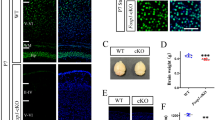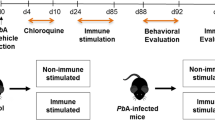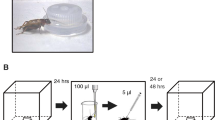The purpose of this study was to assess tactile learning in the early phase of experimental autoimmune encephalomyelitis (EAE), which was induced in C57BL/6 mice by subcutaneous injections on flank of myelin oligodendrocyte glycoprotein, MOG35-55 (250 μg per mouse). Tactile learning was assessed one week after EAE induction using the novel object recognition test (NORT) in a dark room. The procedure consisted of two phases. During the training phase (T1), the animals explored two similar objects; within the test phase (T2, occurring 4 h later) the mice explored one novel and one familiar object. On average, mice developed significant behavioral disabilities related to EAE 13.2 ± 1.9 days following immunization. In the EAE group, the locomotor activity level (assessed by measuring the distance travelled) in the T1 and T2 phases did not differ significantly, as compared to the related phases in the control group (P > 0.05). Within phase T1, no reliable differences between experimental groups were found for the frequency (number) of visits to the sample objects and for total exploration time. For phase T2, no difference was also found in the discrimination ratio when comparing the control group with the EAE group. Our study demonstrates that tactile learning in male mice may not be affected 7 days after immunization with MOG35-55 (i.e., within the early EAE phase).
Similar content being viewed by others
References
P. J. Jongen, A. T. Ter Horst, and A. M. Brands, “Cognitive impairment in multiple sclerosis,” Minerva Med., 103, No. 2, 73–96 (2012).
M. L. B. Ferreira, “Cognitive deficits in multiple sclerosis: a systematic review,” Arq. Neuropsiquiatr., 68, No. 4, 632–641 (2010).
R. H. Benedict and R. Zivadinov, “Predicting neuropsychological abnormalities in multiple sclerosis,” J. Neurol. Sci., 245, Nos. 1/2, 67–72 (2006).
N. D. Chiaravalloti and J. DeLuca, “Cognitive impairment in multiple sclerosis,” Lancet Neurol., 7, No. 12, 1139–1151 (2008).
L. Steinman and S. S. Zamvil, “How to successfully apply animal studies in experimental allergic encephalomyelitis to research on multiple sclerosis,” Ann. Neurol., 60, No. 1, 12–21 (2006).
Y. Pollak, E. Orion, I. Goshen, et al., “Experimental autoimmune encephalomyelitis-associated behavioral syndrome as a model of depression due to multiple sclerosis,” Brain, Behav., Immun., 16, No. 5, 533–543 (2002).
Y. Pollak, H. Ovadia, I. Goshen, et al., “Behavioral aspects of experimental autoimmune encephalomyelitis,” J. Neuroimmunol., 104, No. 1, 31–36 (2000).
J. Tu, C. Zhao, T. Vollmer, et al., “APOE 4 polymorphism results in early cognitive deficits in an EAE model,” Biochem. Biophys. Res. Commun., 384, No. 4, 466–470 (2009).
O. Costa, D. Divoux, A. Ischenko, et al., “Optimization of an animal model of experimental autoimmune encephalomyelitis achieved with a multiple MOG (35-55) peptide in C57BL6/J strain of mice,” J. Autoimmun., 20, No. 1, 51–61 (2003).
M. Onuki, M. M. Ayers, C. C. Bernard, and J. M. Orian, “Axonal degeneration is an early pathological feature in autoimmune-mediated demyelination in mice,” Microsc. Res. Tech., 52, No. 6, 731–739 (2001).
A. Ennaceur and J. Delacour, “A new one-trial test for neurobiological studies of memory in rats. 1: Behavioral data,” Behav. Brain Res., 31, No. 1, 47–59 (1988).
B. Roozendaal, S. Okuda, E. A. Van der Zee, and J. L. McGaugh, “Glucocorticoid enhancement of memory requires arousal-induced noradrenergic activation in the basolateral amygdala,” Proc. Natl. Acad. Sci. USA, 103, No. 17, 6741–6746 (2006).
B. Aisa, R. Tordera, B. Lasheras, et al., “Cognitive impairment associated to HPA axis hyperactivity after maternal separation in rats,” Psychoneuroendocrinology, 32, No. 3, 256–266 (2007).
D. M. Arduino, A. R. Esteves, D. F. Silva, et al., “Therapeutic intervention at cellular quality control systems in Alzheimer’s and Parkinson’s diseases,” Curr. Pharm. Des., 17, No. 31, 3446–3459 (2011).
A. Winkelmann, C. Engel, A. Apel, and U. K. Zettl, “Cognitive impairment in multiple sclerosis,” J. Neurol., 254, Suppl. 2, 1135–1142 (2007).
D. A. Brown and P. E. Sawchenko, “Time course and distribution of inflammatory and neurodegenerative events suggest structural bases for the pathogenesis of experimental autoimmune encephalomyelitis,” J. Comp. Neurol., 502, No. 2, 236–260 (2007).
D. H. Rodrigues, M. C. Vilela, L. S. Barcelos, et al., “Absence of PI3Kг leads to increased leukocyte apoptosis and diminished severity of experimental autoimmune encephalomyelitis,” J. Neuroimmunol., 222, No. 1, 90–94 (2010).
D. H. Rodrigues, N. Lacerda-Queiroz, A. S. de Miranda, et al., “Absence of PAF receptor alters cellular infiltrate but not rolling and adhesion of leukocytes in experimental autoimmune encephalomyelitis,” Brain Res., 1385, 298–306 (2011).
M. O. Ziehn, A. A. Avedisian, S. Tiwari-Woodruff, and R. R. Voskuhl, “Hippocampal CA1 atrophy and synaptic loss during experimental autoimmune encephalomyelitis, EAE,” Lab. Invest., 90, No. 5, 774–786 (2010).
D. H. Rodrigues, M. C. Vilela, N. Lacerda-Queiroz, et al., “Behavioral investigation of mice with experimental autoimmune encephalomyelitis,” Arq. Neuropsiquiat., 69, No. 6, 938–942 (2011).
M. Jones, T. Nguyen, C. Deboy, et al., “Behavioral and pathological outcomes in MOG 35–55 experimental autoimmune encephalomyelitis,” J. Neuroimmunol., 199, No. 1, 83–93 (2008).
F. H. Peng, X. F. Zhong, X. Q. Hu, et al., “Effects of dendritic cell and subgroup changes on bone marrow transplantation treatment of multiple sclerosis,” Neural Regener. Res., 4, No. 11, 874–878 (2009).
N. Popovic, A. Schubart, B. D. Goetz, et al., “Inhibition of autoimmune encephalomyelitis by a tetracycline,” Ann. Neurol., 51, No. 2, 215–223 (2002).
E. Nizri, M. Irony-Tur-Sinai, N. Faranesh, et al., “Suppression of neuroinflammation and immunomodulation by the acetylcholinesterase inhibitor rivastigmine,” J. Neuroimmunol., 203, No. 1, 12–22 (2008).
I. Peruga, S. Hartwig, J. Thöne, et al., “Inflammation modulates anxiety in an animal model of multiple sclerosis,” Behav. Brain Res., 220, No. 1, 20–29 (2011).
E. D. Olfert, B. M. Cross, and A. A. McWilliam, Guide to the Care and Use of Experimental Animals, Canadian Council on Animal Care Ottawa, Ontario, Canada (1993).
Author information
Authors and Affiliations
Corresponding author
Rights and permissions
About this article
Cite this article
Ayoobi, F., Fatemi, I., Roohbakhsh, A. et al. Tactile Learning within the Early Phase of Experimental Autoimmune Encephalomyelitis in Mice. Neurophysiology 45, 306–311 (2013). https://doi.org/10.1007/s11062-013-9373-6
Received:
Published:
Issue Date:
DOI: https://doi.org/10.1007/s11062-013-9373-6




